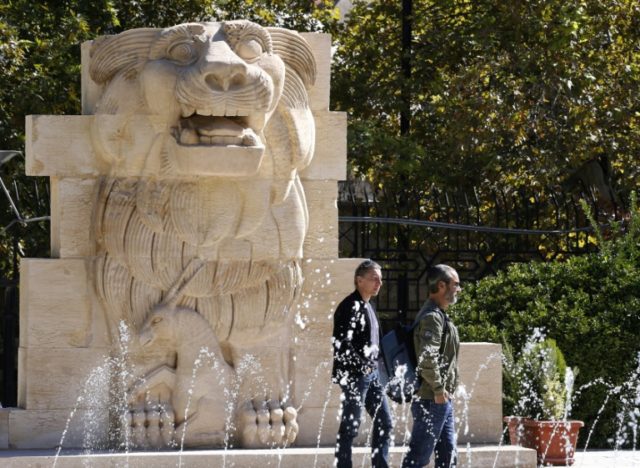Damascus (AFP) – The antiquities museum in the capital of war-torn Syria reopened its doors after six years on Sunday, with a two-millenia-old lion standing proud in the garden.
Its jaws ajar, the three metre stone Lion of Al-Lat towered over a fountain after surviving the country’s seven-year conflict and damage inflicted by Islamic State group jihadists.
The lion was just one of the artefacts on show after the museum reopened one of its wings, revealing once again some of its thousands of treasures for the first time since 2012.
Other parts of the museum are to reopen soon.
The Damascus museum, founded in 1920, was closed one year into the civil war as the then national head of antiquities Maamoun Abdulkarim took action to protect its pieces from rebel rockets or looting.
He was petrified that the country’s museums would be looted like in neighbouring Iraq after the US-led invasion of 2003.
“We closed all doors in all museums in Syria… and we emptied all the halls,” said Abdulkarim.
From 2012 onwards, the museums authority stored some 300,000 items and thousands of manuscripts in secret locations protected from fires, shelling and floods.
The pieces come from 34 museums, including 80,000 items from Damascus alone.
Antiquities official Ahmad Deeb explained how they protected the artefacts.
“We put some in metal boxes. But we surrounded the larger pieces that are tough to transport with cement blocks to protect them,” he said.
– Mosaics and tombs –
The capital’s museum’s gardens, however, remained open to the public, even as rockets intermittently hit the city from the nearby rebel bastion of Eastern Ghouta.
Hundreds of Syria’s archaeological sites have been destroyed, damaged or looted since the start of the war, with all sides blamed for the plundering.
Now part of the Damascus collection is again available for the public to see, after President Bashar al-Assad’s forces earlier this year took back Eastern Ghouta and secured the capital.
Inside, visitors could admire a centuries-old mosaic depicting a panther and a cockerel.
They could once again walk into the elaborate funerary chambers of the Yarhai family from the second century, from the ancient city of Palmyra in the centre of the country.
The main sarcophagus is topped with a limestone sculpture of a man reclining on his side, clutching a goblet.
All around him in what was once an underground burial chamber, limestone figures appear to take part in a banquet.
The whole tomb was transferred from the UNESCO-listed heritage site of Palmyra to the capital in the 1930s.
Safely inside the capital’s closed museum, the tomb escaped destruction by IS when the jihadists overran Palmyra in 2015.
But the Lion of Al-Lat was not so lucky.
The stone lion was first discovered at the temple of Al-Lat, a pre-Islamic Arabian goddess of war and peace, in Palmyra in 1977.
Bartosz Markowski, a Polish archeologist, helped restore the statue in 2005 as a relief, only to see it ravaged by IS just a decade later.
– New addition –
“When Daesh came to Palmyra it was the first thing they destroyed,” he said, using the Arabic acronym for IS.
The extremist group considers statues of humans or animals as blasphemous.
Known to Syrians as the “Pearl of the Desert”, Palmyra was home to some of the best preserved classical monuments in the Middle East.
But following their capture of the city, IS beheaded Palmyra’s 82-year-old former antiquities chief and launched a campaign of destruction against its treasured monuments.
After Russia-backed regime forces retook Palmyra in 2016, Markowski took part in a second restoration that finished one year ago, bringing the lion to a new home in the Damascus garden.
Between the lion’s legs, an antelope rests, a hoof extended over one of the lion’s muscular paws.
“It was the first sculpture that was restored after the crisis, and it was an important thing for the people,” said Markowski.
“They could have seen the lion as a symbol… that the crisis is going away — slowly but the situation is getting better,” he said.
Today, the Syrian regime is in control of around two-thirds of the country.
This week, the Polish expert and his team gave the lion its final touches, adding the antelope’s nose which had gone missing.
The head of the Palmyra museum, Khalil Hariri, said he hoped the lion would eventually return to its home city.
“A piece is more beautiful where it belongs,” he said.

COMMENTS
Please let us know if you're having issues with commenting.